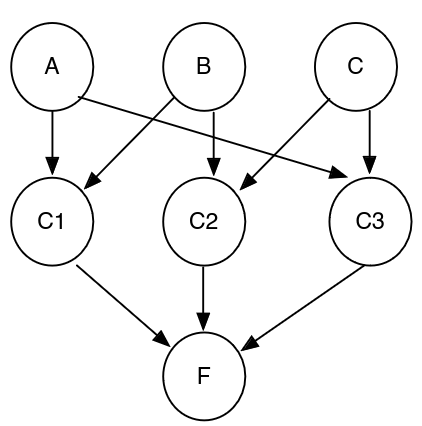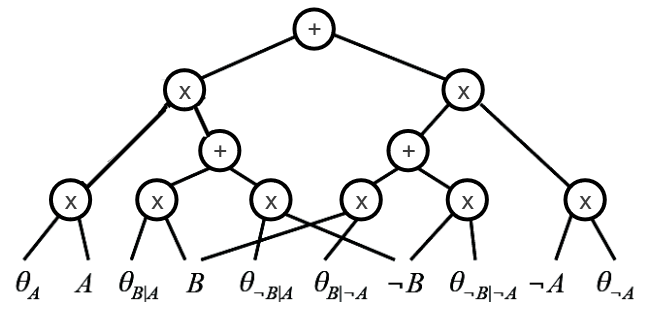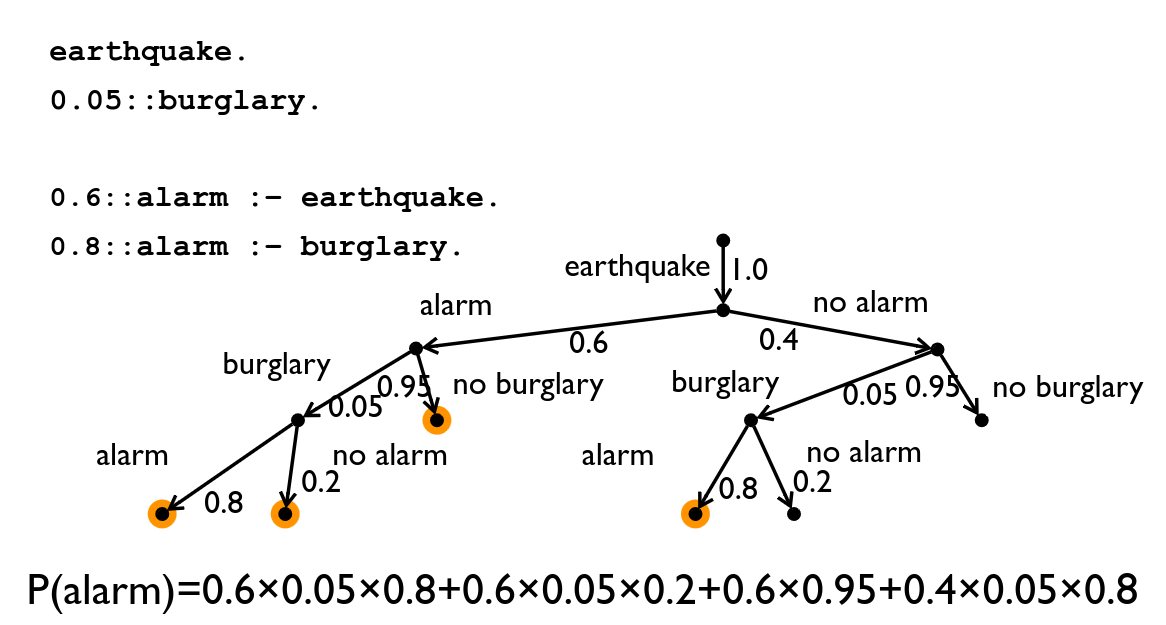Logic & Probability
Table of contents
From SAT to WMC
Satisfiability (SAT)
With a SAT problem we are given a set of boolean variables and a set of clauses of the form \(l_1 \lor \dots \lor l_k\) (k=3, 3-SAT), with each literal a positive or negative variable. The goal is to find an assignment of truth-values to the variables such that all clauses are satisfied.
Example: Lets say we have the following clauses:
\[A \lor B \lor C\] \[\neg A \lor \neg B \lor \neg C\]A possible solution is \(A = true, B=false, C=true\)
Solutions are called models, one often works with general boolean expressions instead of k-CNF (conjunctive normal form).
All the solutions for this example are: where we have 6 models

Inference in BN is hard
Can we encode SAT as a BN inference problem?
Consider the following example:
\[(\neg A \lor B) \land (\neg B \lor C) \land (A \lor C)\]- Assign the priors of \(A, B, C\) as 0.5, and have the other CPTs defined deterministically ( that is, \(C1\) is true iff \(\neg A \lor B\))
- Then \(p(F) > 0\) iff the formula is satisfiable
- So, BN inference is at least as had as SAT. (NP-hard)

From SAT to #SAT and WMC
What is the difference between SAT, #SAT and WMC?
- SAT: doest there exist a model for a logical theory?
- #SAT: how many models are there for a logical theory? (model counting)
- WMC: what is the weighted model count?
How do we now go from SAT to #SAT and WMC?
For the previous theory (figure above), there were three models. In the BN, each possible world had a probability of 1/8 and each literal of 0.5 (weight of 0.5). We can now define the weighted model counting problem (WMC) as:
- Given is a logical theory T (usually in CNF)
- for each literal \(l\), there is a (non-negative) weight \(w(l)\)
The weighted model count of the theory \(wmc(T)\) is then:
- \(wmc(T) = \sum_{M \models T} w(M)\) (where \(M\) is model for \(T\), \(M\) is the set of all true literals)
- \[w(M) = \prod_{l \in M} w(l)\]
DPLL

- In a CNF theory \((A \lor \neg B) \land (C \lor D)\), the clauses are the disjunctions, that is, \((A \lor \neg B)\) and \((C \lor D)\)
- A unit clause contains exactly one literal
- An empty clause is a disjunction of 0 literals, at least one of which must be true
Example:

Inference via WMC
We can do this in four steps:
- Encode the BN as a boolean expression
- Compile the boolean expression into a special data structure (an sd-DNNF)
- Turn the sd-DNNF into an arithmic circuit
- Perform inference

- We start from the full CPT (with ALL entries, that is for both true and false)
- Each possible entry/parameter in a CPT is encoded as a logical expression
- The weights are as follows: \(w(A) = w(\neg A) = w(B) = w(\neg B) = 1\) and \(w(\neg \theta_x) = 1\) but \(w(\theta_x) =\) entry in CPT (as there is no evidence and we are interested in the weighted model count of the complete theory)

We can now convert it to an arithmic circuit, by replacing AND by multiplication and OR by addition:

ProbLog
In normal Prolog programs, we have facts and rules, the facts are always 100% true. In ProbLog, we give each fact a probability, which is then used to compute the probability of a query.

As you can see, OR’s are replaced by addition and AND’s by multiplication.